There are a number of ways you can help seabirds on O‘ahu. Kokua with one or choose them all! If you have ideas on how to help seabirds, let us know at oahuseabirdgroup@gmail.com.
Report Injured or Dead Seabirds
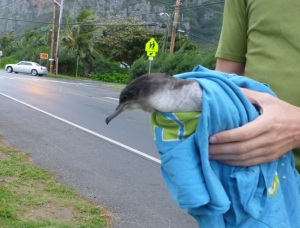
This wedge-tailed shearwater was found by the roadside in Waimanalo
Every year from October-December, juvenile wedge-tailed shearwaters or ‘u‘au kani are taking first flight out to sea. They often get disoriented by lights, collide with structures, and may fall to the ground, where they then become vulnerable to predators or hit by vehicles.
Most times, the seabird is just temporarily disorientated or may simply be resting near a nest and will be fine if left alone. However, after observing the bird for 10 minutes and it seems in distress, you can call the Hawai‘i State Division of Forestry and Wildlife at 808-973-9777, the U.S. Fish and Wildlife Service at 808-792-9400, or the Hawai‘i Wildlife Center, who can answer questions and provide guidance 7 days a week from 9am-5pm via phone at 808-884-5000. More information from DLNR can be found here. Hawai`i Wildlife Center has more information at: How to rescue an injured bird and Seabird fallout response.
A licensed veterinarian can also provide emergency care for up to 24 hours, and under federal law (Migratory Bird Treaty Act) there is a “good Samaritan” provision which allows an individual to possess a wild bird just long enough to transport it to a rehabilitator or veterinarian for medical care. However, note that veterinarians my require payment.
If you need to transport the seabird to another location, quietly approach the bird and gently pick it up by placing a towel, t-shirt, or small sheet over the bird. Be careful of the beak as these birds can bite. Place it in a container with a lid (e.g., well-ventilated, clean, dry – can be a cardboard box, plastic tub or dog/cat carrier large enough for the bird to comfortably sit or stand) with a towel or soft cloth (like a t-shirt) on the bottom. Keep the container in a quiet, cool, and shady/dark place. Do not try to give it food or water. If you have handled the bird with no gloves, wash your hands afterwards.
Day to Day Actions

Laysan albatross chick
- Don’t let pets run loose. Keep your cats indoors and dogs securely fenced or on a leash when walking. Many seabirds lay nests on or underground and are vulnerable to dogs and cats, which injure or kill seabirds. Some of these animals are abandoned or feral, and some are pets that have been allowed to roam.
- Report stray animals to the Humane Society or local Animal Control Officer.
- Look for downed birds, especially in October-December.
- Seabirds get disorientated by our lights so turn off or minimize your outdoor lighting and use directional or shielded lighting to concentrate light to areas where needed, especially if you live on the coast.
- Encourage local officials to adopt a shutoff time for tall lights in parks and stadiums instead of leaving them on all night (saves taxpayers money too!)
- If visiting an offshore islet, stay on the beach, as birds may be burrowing inland and you could mistakenly crush them or their young.
Volunteer
- Wedge-tailed shearwaters raise their young in a neighborhood community. Help
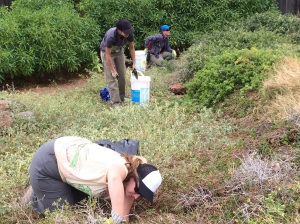
Volunteers at the Freeman Seabird Preserve readying nests to welcome back the wedge-tailed shearwaters
the Hawai‘i Audubon Society clear weeds, plant native plants, prepare nesting sites, and other activities during the months of January-March. To learn more, visit Freeman Seabird Preserve.
- Wanna get up close and personal? The State of Hawai‘i Department of Land and Natural Resources’ Division of Forestry and Wildlife (DOFAW) manages several offshore islets, which are seabird sanctuaries. They are always looking for volunteers to assist with habitat management and restoration. To learn more, visit their Facebook at Oahu Offshore Island Restoration Program.
- Home to nesting Laysan albatross and wedge-tailed shearwaters, Kaena Point Natural Area Reserve needs volunteers so check it out.
- Kure atoll is located in the Northwestern Hawaiian Islands, but is actually part of Honolulu county. Every year, they look for volunteers to work and live there for 6 months. A life changing experience! To learn more, visit Kure Atoll Ecological Field Station Project or the Kure Atoll Conservancy, a 501(c)(3) non-profit which supports work there.
- Sea Life Park has both internship and volunteer opportunities available. Information can be found here.
- Every year during November-December, juvenile wedge-tailed shearwaters fly out to the ocean to begin their lives at sea. Unfortunately, they get disorientated by
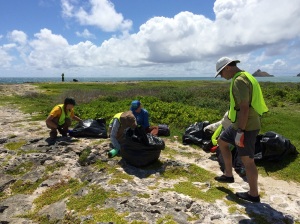
Volunteers helping to pull out invasive plants at Popoi‘a island in Kailua
man-made lights and collide with structures such as utility poles where they then fall to the ground. They become vulnerable to predators such as cats or hit by vehicles. Volunteers are needed to help answer calls about downed birds and pick up the birds to drive them to facilities/people who are trained to assess the condition of the birds and rehabilitate them if needed. Volunteers are also needed to coordinate this network of volunteers. Please contact oahuseabirdgroup@gmail.com if you are interested.
Donate Supplies and Equipment
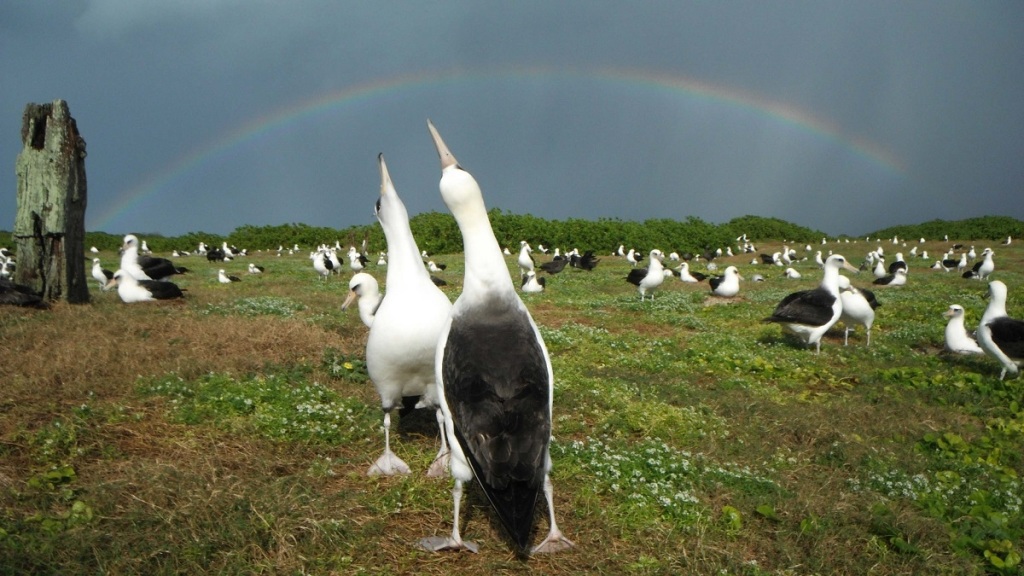
Laysan albatross courting
There are many efforts going on around the island to support restoration of seabirds. They vary in the level of funding received to carry out activities and are often in need of supplies and equipment.
Please check back again for items that might be needed.
Get Educated
Learning about seabirds, their threats, and their conservation needs and sharing this with others is a great way to support restoration of seabirds on O‘ahu.
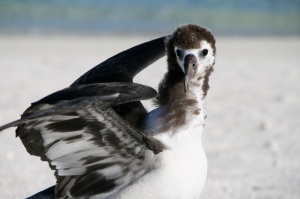
A juvenile Laysan albatross going through an awkward teenage stage
- To learn about the biology, threats, and conservation needs of individual seabirds, as well as management resources such as agencies, laws, and plans visit our Learn About Seabirds page.
- Visit our Common Questions page.
- The Conservation Council of Hawai‘i has produced a poster called “Care for the seabirds of Hawai‘i Nei” which also includes a teacher’s guide.
- Learn about other seabird initiatives on the neighbor islands:
Aloha! I am a real estate appraiser and I have a client who unknowingly bought a house on the water in the Milokai area of Oahu that has a large population of shearwaters. Their presence had not been disclosed to him. The noise they generate has proved distressing to him. In order to do my research on their impact on value, I need to know how long they have been in that area. Can you help me with this problem? If not, can you direct me to someone who can? Thank you for whatever help you can provide.
Andrew Rothstein, MAI, AI-GRS, AI-RRS
LikeLike
Just Because
LikeLike